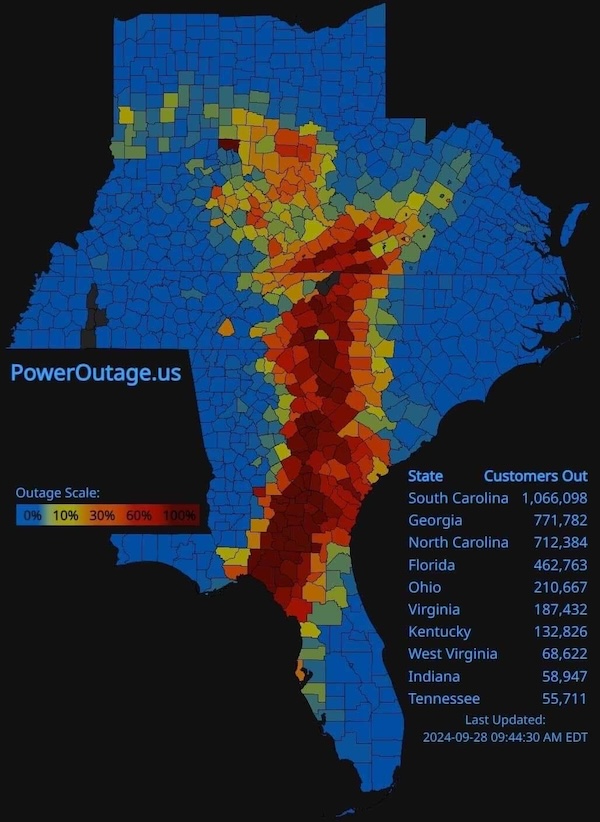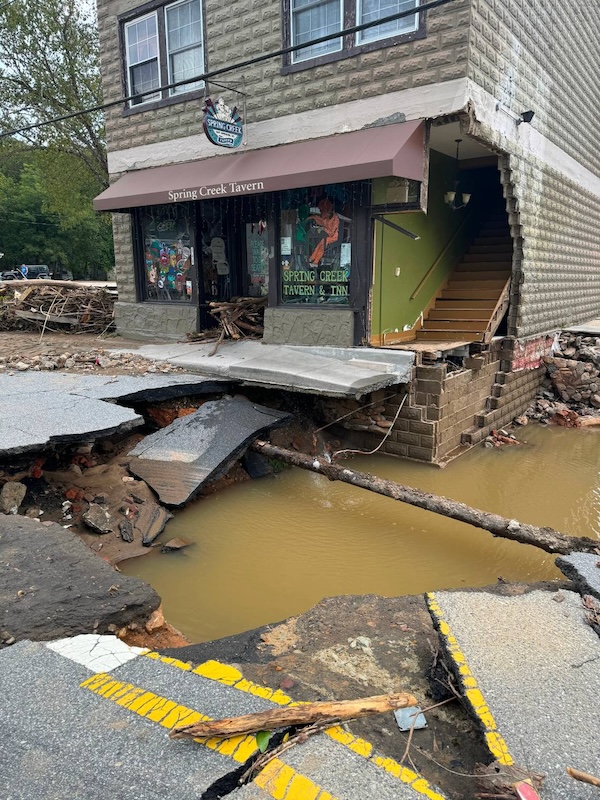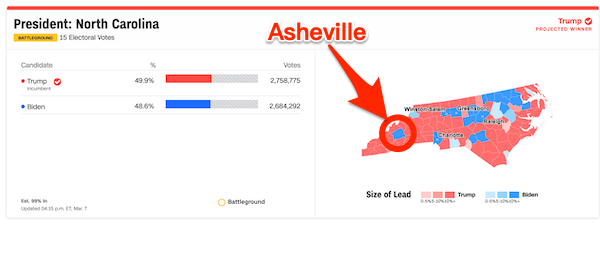By Lambert Strether of Corrente
Patient readers, I apologize for being slow. I just bit off more than I could chew! Still, I hope the conclusion has merit. –lambert
Hurricane Helene was a brutal force. Taking loss of power as a proxy for damage, this map from PowerOutage.us shows how bad it was:

Red is bad. That’s a lot of red. In this post, I’m going to examine the Helene’s effects on Western North Carolina (WNC) only, and not other states in Helene’s path, partly because my academic family had a connection with Duke, and so I have childhood memories of the state, but mostly because the relationship between topography, demography, voting patterns, and the impact of Helene presents attractive possibilities for political analysis of a critical swing state that I did not see elsewhere (analysis that may apply to other Appalachian states, but I don’t have time to do that research). Damage to two institutions of national, even global significance — the National Centers for Environmental Information, and the quartz mines of Spruce Hill — is described in an Appendix.
North Carolina Governor Roy Cooper (D) described Helene’s impact in his letter to President requesting disaster relief:
Hurricane Helene entered the Florida panhandle as a Category 4 hurricane and moved northward impacting North Carolina with significant, damaging, and lifethreatening flash flooding across the western portions of the North Carolina .
Widespread, catastrophic flash flooding is being experienced across the Blue Ridge Escarpment. Rainfall amounts through midday, Friday, September 27, 2024, have reached up to 20 inches in some locations creating power outages, major highway closures, major transportation stoppages, and the need for rescues and evacuations. Numerous landslides, with large damaging debris flows and slope failures, are occurring along the Blue Ridge Escarpment and in western North Carolina. Tornado watches are in effect for Eastern and Central North Carolina. Wind gusts reaching 35 mph are ongoing and isolated tornadoes have been reported throughout the State. Two deaths have been confirmed in North Carolina due to weather-related impacts.
Numerous river gauges have rapidly climbed above flood stage, with seven rivers (French Broad, Swannanoa, Pigeon, Broad, Catawba, South Fork Catawba, and Yadkin) at major flood stage and eighteen at moderate flood stage. Tropical Storm Helene has caused widespread damage including downed trees and flooding that blocked roadways, damaged residential structures and businesses, and caused at least 900,000 power outages and climbing. The investor-owner, municipal, and co-opt utilities have reported significant damage to the electric infrastructure in western and portions of central North Carolina and assessments are ongoing. Communication services have been degraded or are completely unavailable.
(Remember that word, “mountains.”) Helene’s effects have been discribed as “apocalyptic” “biblical devastation.” “The worst flooding in a century” has put both dams and water supplies at risk (and floodwater is unhealthy, not to say toxic). More than 400 roads are out, including I-40, the East-West artery of WNC, not that cars could gas up anyhow, with gas stations closed. Besides the power outages mentioned by Cooper, cellphones are out, too (the towers having gone down), although ham radio still functioned(1). As of this writing, 1000 people are unaccounted for, and the death toll is rising. And if Hurricane Ian is any indiction, WNC residents will end up being defrauded on their insurance claims. Meanwhile, gutted newsrooms have made media coverage miserably inadequate.
There are many, many images of damage, on the Twitter, but I picked this one of Fulton, NC. Fulton looks like a war zone:

What struck me was that “Spring Creek,” gone mad in the storm, had ripped open the road to expose the town’s water system.
And now to those mountains.
How Topography Shaped Western North Carolina
Wikipedia (sorry) describes WNC’s topography:
(WNC)is the region of North Carolina which includes the Appalachian Mountains; it is often known geographically as the state’s Mountain Region. It contains the highest mountains in the Eastern United States, with 125 peaks rising to over 5,000 feet (1,500 meters) in elevation. Mount Mitchell at 6,684 feet (2,037 meters), is the highest peak of the Appalachian Mountains and mainland eastern North America…
Located east of the Tennessee state line and west of the Piedmont, Western North Carolina contains few major urban centers. Asheville, located in the region’s center, is the area’s largest city and most prominent commercial hub. The Foothills region of the state is loosely defined as the area along Western North Carolina’s eastern boundary; this region consists of a transitional terrain of hills between the Appalachians and Piedmont Plateau of central North Carolina.
Areas in the northwest portion of the Western North Carolina region, including Boone and Blowing Rock, commonly use the nickname ‘The High Country’. The term Land of the Sky (or Land-of-Sky) is a common nickname for the Asheville area. The term is derived from the title of the novel, Land of the Sky (1876), written by Mrs. Frances Tiernan, under the pseudonym Christian Reid. She often refers in this book to the Great Smoky Mountains and Blue Ridge Mountains, the two main ranges in Western North Carolina. The Asheville area regional government body, the Land-of-Sky Regional Council, uses this nickname.
WNC’s mountainous topography had several consequences.
First, historically, WNC’s terrain was not suitable for rice, tobacco, cotton, or plantations generally. This did not mean that slavery did not exist in WNC; but there were fewer slaves — i.e., Blacks — than in areas more suitable for the Slave Power’s version of Big Ag. From Asheville Watchdog:
By 1860, about 15 percent of the population of Western North Carolina was enslaved. Only a small percentage of the White settlers… owned slaves — about 2 percent of households, according to Katherine Calhoun Cutshall, collections manager, North Carolina Room, Pack Memorial Library — and of those, most owned one or two. The majority were owned by a handful of elite families, whose names are commemorated throughout the region.
They used their wealth and influence to help build Asheville and surrounding communities, supporting government, schools, healthcare, infrastructure, parks and other civic improvements, for which they were honored. But the wealth that lifted them to prominence was derived in large part by the enslavement and exploitation of Black people, entwining their many good deeds with the evil of racism (Or rather, the evil of property in persons).
2% of white households owning slaves contrasts to 45.8% in South Carolina; and 15% of the population contrasts to South Carolina’s 50%+, or Georgia’s 44%(2).
Second, WNC’s terrain makes for many small towns and a scattered population. From Renee Robinson on Twitter:
I need people to understand something with the news coverage regarding effects of hurricane Helene. There is a lot more to the NC Mountains than Asheville.
Boone, Blowing Rock, Banner Elk, Vilas, Sugar Grove, Elk Park, West Jefferson, Black Mountain, Swannanoa, Sylva, Cullowhee, Brevard, Bryson City, Hendersonville, Cherokee, Waynesville, Burnsville, Candler, Canton, Spruce Pine, Chimney Rock, Lake Lure, Linville, Marshall, Maggie Valley, Newland, Grandfather, Beech Mountain, Sugar Mountain, Old Fort, Morganton, Marion are just a few of the cities and towns that have been flooded and/or destroyed. The counties of Yancey, Mitchell, Avery, Ashe, Watauga, Transylvania, Burke, Caldwell, Alleghany, Madison, Buncombe(3), McDowell, Rutherford, Polk, Henderson, Wilkes, Haywood, Jackson, Macon, Clay, Cherokee, and Swain are devastated and in need of the same help, some even more.
Other counties that fall under various definitions of Western North Carolina include: Alexander County, Catawba County, Cleveland County, Surry County and Yadkin County. When these counties are added, they form a total regional area of roughly 11,750 square miles (30,400 km2). This makes the region roughly the size of Massachusetts. Western North Carolina holds 11% of our state’s population.
There are millions of people up there with no electricity, no communication, no water, and no way to get out or let rescue teams even know where they are. I am not taking anything away from Asheville and the utter destruction there or any other areas in NC that have damage. The level of destruction is unimaginable. But it’s not one or two cities or towns that are in need of help.
Matt’s Weather Rapport describes the isolation of the people across WNC:
I’m not just talking about a few backwoods hollows in the mountains. It’s virtually the whole region. The crisis is worsening, and I fear the death toll up there will skyrocket.
Much like Vermont, there’s tons of narrow, winding mountain roads in the region leading to an unknown number of houses, trailers, camps, resorts and local tourist attractions. The flooding and mudslides up there were cataclysmic. Since there’s no communications and electricity working, and nobody can get up there, nobody knows how many people have passed away, or are dying while they wait.
Small towns outside of Asheville like Castle Rock, Old Fort, Roan Mountain and Swannanoa have been almost completely destroyed. Accessing them will be harder than getting into Asheville.
Third, WNC’s elevation led people to believe it was safe, a “climate haven”:
Reminder that Western NC was considered a “climate haven” in the US.
Don’t think the impacts of climate change won’t reach you. Asheville is over 250 miles inland and 2,000 feet above sea level.
This isn’t normal and we need to address this as a climate crisis. pic.twitter.com/9HmTpXQw7b
— Nomadic Activist | Nicole 🌎 (@nomad_activist) September 29, 2024
That doesn’t affect election 2024, but it is one of life’s little ironies, eh? Now let’s turn to truly important, contemporary affairs: Politics.
Western North Carolina, Hurricane Helene, and Election 2024
As readers know, North Carolina is a swing state, one of the states where a few thousand votes either way could determine the outcome of a Presidential election. It’s currently tied (within the margin of error). From Project FiveThirtyEight, though other pollsters agree:

Here is Joe Biden, juxtaposed by a Republican source: At the top, he’s dispensing largesse to Ukraine; at the bottom, he’s answering a question about disaster relief:
“$2.4 billion aid to Ukraine” vs “No more aid for Hurricane Helene” – 3 days apart pic.twitter.com/zA2CxzNPiG
— End Wokeness (@EndWokeness) September 30, 2024
The optics in the bottom panel are horrid: Biden, questioned on his relief efforts for devastated states, looks angry and hostile, and snaps that he’s sent “a significant amount even though they didn’t ask for it yet.” With two swing states in Helene’s path — George and North Carolina — reeling from an apocalyptic event in an election year, and he can’t work up any other emotion than tight-lipped annoyance? Oh well. That said, the real issue here is whether, in fact, the generally molasses-brained Biden Administration delayed relief, or not.
The Republican narrative is that “our goverment” delayed(4):
Ashville, NC is getting the same treatment as Maui from our government.
Legacy media is MIA. pic.twitter.com/jX5ZA26k4f
— Spitfire (@DogRightGirl) September 29, 2024
But let’s go to the tape. There are two ways that a disaster is declared, says FEMA. The first is an Emergency Declaration, declared by the President, with a top limit of $15 million (this is the “significant amount” Biden sent more or less immediately). The second is a Presidential Disaster Declaration, which triggers FEMA, but which a state must request. Helene roared through on September 26-27; Governor Cooper made his request on September 27; President Biden granted it on September 28. Now, there may be plenty of reasons to quarrel with FEMA’s performance in the coming days, but as far as setting the wheels of government in motion, I don’t see a difficulty with the Biden Administration. (Sadly, the Republican spokesman on this issue is gubernatorial candidate Mark Robinson, who has his own issues.)
Campaign trivialities aside, how will Helene’s devastation affect voters on 36 days from now? Here is where the topography and demographics of WNC come into into play. Recall first that owing to its topography WNC is more white (that is, less Black) than the rest of North Carolina. Second, WNC is less educated, and more poor, than the North Carolina average. In other words, WNC is Trump Country (modulo the Trump voters who are golfers, crypto bros, financial barons, and so forth). A map from the 2020 Presidential election shows this clearly:

Asheville (population 94,589), with its eleven area colleges, vibrant arts scene, and Biltmore estate (now underwater) is the quintessential Blue City in a sea of Red.
Now let’s ask ourselves which voters in WNC are most likely to be able to make it to the polls and cast their votes, 36 days from now, based on their respective terrains. For the city of Ashville: I would imagine that one way or another, I-40 will be opened as soon as possible. Voting locations in schools and churches are concentrated, and one can be easily substituted for another. Some voting locations may even be within walking distance. Power and communications will also be opened — AFAIK, Internet service at the Asheville town library functioned throughout — not least so that rescuers can fan out from Asheville to more remote locations. For the mountains of Trump Country: Miles of winding roads will remain closed. Voting locations are far apart, and thinly scattered, so that substitution is not easy. Many voting locations can only be reached by car. Power and communications will be restored more slowly. The net result will be that most voters in Blue Asheville will be empowered relative to many voters in Trump Country (no matter their desires. It doesn’t matter if you’d crawl over broken glass vote for Trump if “you can’t get there from here”).
Conclusion
Trump won North Carolina in 2020 by a margin of 2,758,775 – 2,684,292 = 74,483. Even if Hurricane Helene takes away only (say) 10% of those votes from Trump Country, that could be enough to swing the state to Kamala, if she does a little better in other parts of the state. Continued volatilitiy!
P.S. North Carolina readers, please correct me. I really enjoyed reading up on the state!
NOTES
(1) From QRPer:
I’ve heard it all my life: when all else fails, ham radio still works. And let me tell you, it’s true.
Throughout the storm, our normally quiet repeater systems were buzzing with activity. The traffic became very organized, with hourly nets helping pass messages to family and friends, sharing detailed on-the-ground reports, and identifying areas where help was needed. Even though our emergency services are overwhelmed, we’re able to connect with them via amateur radio networks like ARES.
Right now, being a ham feels like a superpower. For many people, it’s the only form of communication that still works.
(2) The mountainous terrain also permitted a degree of social experimention. From WNC Magazine, “The Happy Land“:
It began, the stories say, with a search party of sorts: a caravan of emancipated African Americans traveling up from the Deep South, looking for a place where they could embrace freedom, safety, and self-sufficiency—a haven for putting down roots and building a new life. They found it in the southern reaches of Henderson County, where they established the Happy Land, or perhaps the Kingdom of the Happy Land—accounts differ on the precise name. For decades following the Civil War, a singular communal experiment existed, and it became the stuff of legend.
Chronicles of the Happy Land have proved as divergent as the paths that brought those freed slaves to their destination. Little of their venture was written down at the time, but stories added to the record decades later have helped paint a picture of how the kingdom’s residents came to their unique way of living, how they prospered, and how their saga was ultimately cast to the winds of history.
In Western North Carolina’s higher elevations—’mountains that stretched for miles without habitation, where newly freed slaves might find a small piece of land to call home.
(3) The term “Buncombe” did indeed originate from Buncombe County.
(4) I don’t think the Maui analogy is a good one. The topography and the scale were completely different; and the failures were local, not Federal.
APPENDIX National Institutions Affected
First, NOAA’s National Centers for Environmental Information. From Axios:
Hurricane Helene’s severe flooding knocked offline the top tracker of U.S. and global climate data, including of extreme weather.
The National Centers for Environmental Information also maintains and updates NOAA’s list of billion-dollar extreme weather and climate events.
According to NOAA, which runs NCEI, the building currently has electricity but no running water, and won’t be fully occupied until services are restored.
In a statement to Axios, NOAA also said the center’s network connection is down, an outage expected to last days.
Second, the quartz mines in Spruce Pine, NC. From the Verge:
(Helene’s) devastation also reached the small town of Spruce Pine, which is home to the purest quartz on Earth.
Spruce Pine’s high-quality quartz is an essential ingredient in the chipmaking process, as it’s the only naturally occurring source of the ultrapure mineral. The quartz mined from this area is used as a crucible to melt polysilicon, which is then used to produce silicon wafers — the base of a semiconductor.
Even though it’s possible to produce pure silicon from the quartz found in abundance elsewhere in the world, it takes a considerable amount of time and resources to do so, according to a 2018 report from Wired. Hurricane Helene dumped more than two feet of rain on Spruce Pine, with several reports on X showing extreme damage and flooding that has made roadways inaccessible, while many people in the area are without power.
But with communication in the region still extremely difficult, it’s been hard to determine whether the two mining companies that operate in the town — Sibelco and The Quartz Corp — are affected….
As pointed out by Wired, a 2008 Spruce Pine fire ‘all but shut off the supply of high-purity quartz to the world market, sending shivers through the industry.’ If the two mines sustained damage this time around, the impact could be even greater, given the world’s increased reliance on chips to make phones, processors, solar panels, and other technology.





